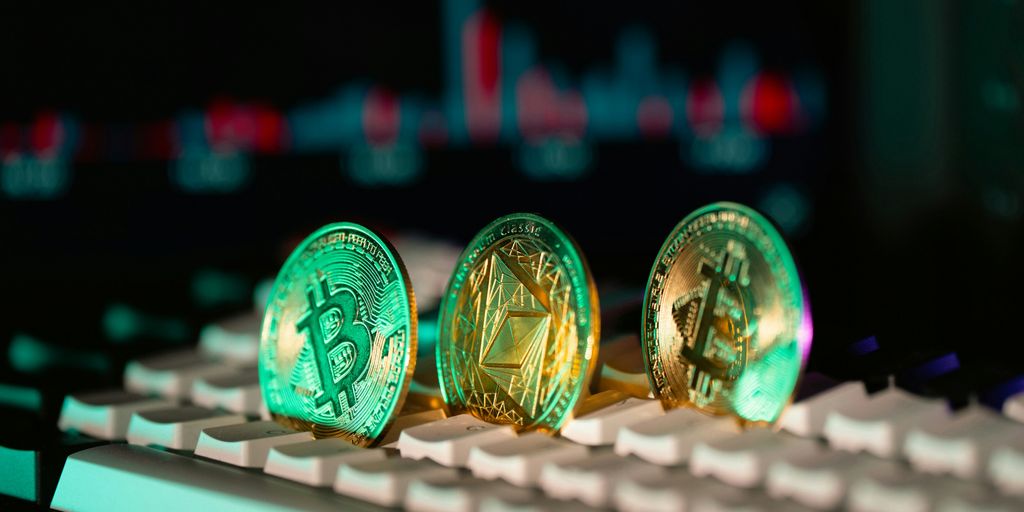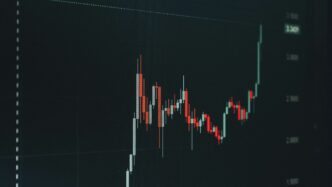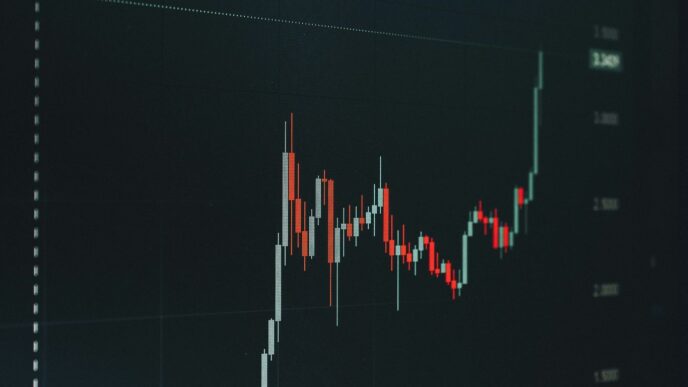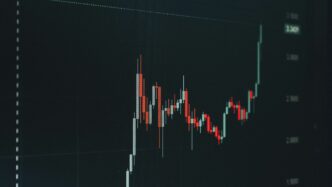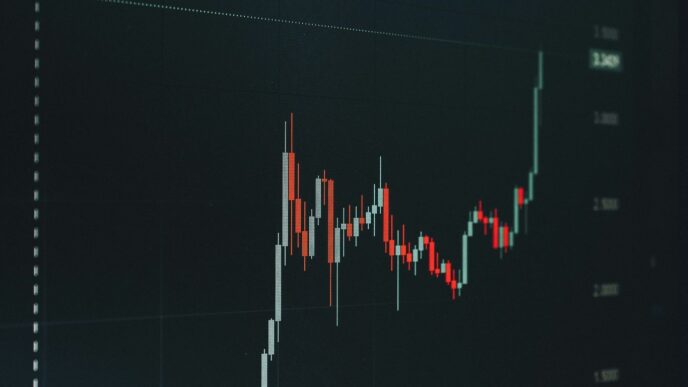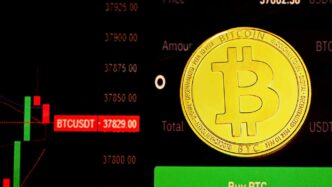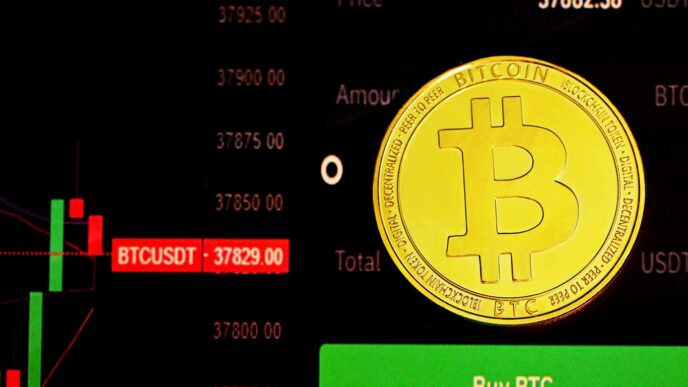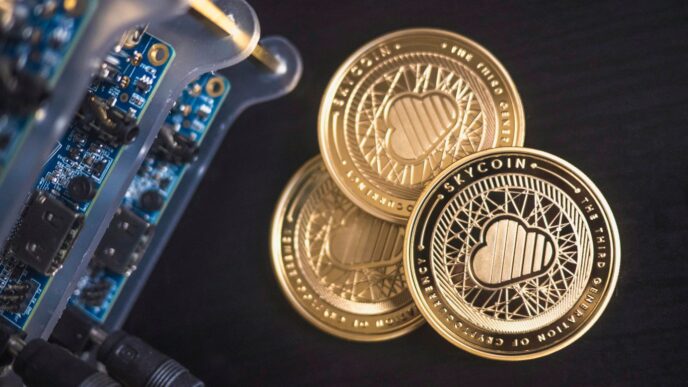So, you’ve probably heard about AI tokens making big moves lately. While Bitcoin and other major coins get a lot of buzz, the AI sector has been quietly, or not so quietly, exploding. Among these, a token called TAO has really caught people’s eye, with its value going way up. But a lot of folks don’t really know much about Bittensor, the project behind it. This article will try to explain what Bittensor is about, how its token works, and what makes it different from other AI projects out there. We’ll also look at its market performance and what might be next for TAO price.
Key Takeaways
- Bittensor wants to create a decentralized network for AI, where different models can work together and get paid in TAO.
- The TAO token was launched fairly, meaning no big private sales, and its supply is limited, similar to Bitcoin.
- TAO’s price has gone up a lot, but it’s important to compare it to other AI tokens and understand its market value versus its total potential value.
- Even though it had a fair launch, big investors are now getting involved with TAO, showing growing interest in its unique approach.
- Bittensor stands out because it focuses on AI algorithms and models, not just computing power, which makes it different from many other AI projects.
Understanding Bittensor’s Core Mission
Bittensor is doing something pretty interesting in the AI world. It’s not just another company building AI models; it’s trying to create a whole new way of developing and using AI, one that’s more open and decentralized. It’s still early days, but the potential is there.
The AI Oracle Concept
Imagine an oracle, but instead of predicting the future, it provides real-time, AI-driven insights. That’s kind of what Bittensor is aiming for. It wants to be a source of truth for AI, where information is gathered and validated by a network, not a single entity. This could be huge for things like financial forecasting, scientific research, or even just getting reliable answers to complex questions. The idea is that by having many different AI models contributing, you get a more accurate and less biased result. It’s like the wisdom of the crowds, but with algorithms. Bittensor’s incentive mechanisms are key to making this work.
Decentralized AI Supply Chain
Think about where AI models come from now. Usually, it’s big tech companies with tons of resources. Bittensor wants to change that by creating a decentralized AI supply chain. This means that anyone can contribute their AI models, data, or computing power to the network and get rewarded for it. It’s like open-source software, but for AI. This could lead to a lot more innovation and diversity in the AI space, as well as making AI more accessible to smaller players. It also means that AI development isn’t controlled by a few powerful companies.
Beyond Traditional AI Production
Bittensor isn’t just about making AI models; it’s about creating a whole new ecosystem around AI. This includes things like:
- AI marketplaces: Where people can buy and sell AI models or data.
- Decentralized AI training: Allowing anyone to train AI models without needing huge amounts of computing power.
- AI-powered applications: Building new applications that are powered by the Bittensor network.
The goal is to create a self-sustaining ecosystem where AI can flourish and benefit everyone, not just a select few. It’s a pretty ambitious goal, but if they can pull it off, it could really change the AI landscape.
The Role of TAO in the Bittensor Ecosystem
Incentivizing Network Participation
The TAO token is the lifeblood of the Bittensor network, designed to encourage participation and contribution from various actors. It’s not just a currency; it’s a reward system and a mechanism for governance. Think of it like this: the more you contribute to the network’s success, the more TAO you earn. This creates a positive feedback loop, attracting more talent and resources to the platform. The tokenomics are structured to reward validators, miners, nominators, and even users, each playing a vital role in the ecosystem.
- Validators: They stake TAO to evaluate AI models and earn rewards for accuracy.
- Miners: They provide AI models and get TAO based on their contributions.
- Nominators: They delegate TAO to validators, earning rewards like liquidity staking.
- Users: They pay TAO to access and use the AI models.
Fair Launch and Tokenomics of TAO
Bittensor took a different approach with its token launch, opting for a "fair launch" in 2021. This means no pre-mined tokens or special allocations for insiders. Everyone had an equal opportunity to acquire TAO from the start. The total supply is capped at 21,000,000, a deliberate nod to Bitcoin’s scarcity model. Like Bitcoin, TAO also has a halving cycle, occurring every 10.5 million blocks. This mechanism reduces the block reward over time, aiming to control inflation and increase scarcity. The next halving is scheduled for August 2025. It’s going to take a while to mine all the tokens, about 256 years, to be exact. This long-term distribution plan is designed to ensure the network’s longevity and sustainability. The TAO token incentivizes network participants.
Long-Term Token Distribution
The extended distribution schedule is a key aspect of TAO’s design. It’s not a get-rich-quick scheme; it’s a long-term project. This approach encourages participants to think about the future of the network and invest in its success. The halving events will gradually reduce the rate at which new TAO is created, potentially increasing its value over time as demand grows. This also means that early participants have a greater opportunity to accumulate TAO, but it also ensures that new participants can still earn rewards for contributing to the network. It’s a balancing act, designed to create a sustainable and thriving ecosystem. The long-term vision is to create a decentralized AI marketplace where TAO is the primary currency, facilitating the exchange of AI models and services.
Market Performance and Valuation of TAO Price

Analyzing TAO’s Price Trajectory
TAO’s price action has been pretty interesting. It’s not just about looking at the raw numbers, though. We need to consider the broader market context and what’s driving the price. It’s gone up quite a bit from its lows this year, but so have other AI tokens. For example, the Grok xAI API collaboration is set to enhance data analysis and insights within blockchain ecosystems. Just looking at price increases alone doesn’t tell the whole story.
Comparing TAO with Other AI Tokens
When you stack TAO up against other AI projects, it gets more interesting. Right now, TAO’s market cap is second only to RNDR. But here’s the thing: because of how TAO is released over time (that four-year halving cycle), its market cap to fully diluted value ratio is the lowest. What that means is that TAO has a relatively low circulating supply right now, but each token is worth quite a bit. It’s like having a small number of really valuable coins.
Market Capitalization Versus Fully Diluted Value
Low circulation can make the price jump more easily because there’s less available. At a price of, say, $160, if all the 7,200 TAO mined each day were sold, the market would see about $1.15 million in selling pressure. But with TAO’s daily trading volume around $5 million, that selling pressure probably isn’t a big deal. To really understand TAO’s value, you have to compare it to similar projects, not just look at it in a vacuum. Bittensor is focused on crypto + algorithms/models, so it’s not really the same as projects like RNDR that are all about providing computing power. According to some reports, Bittensor is more in the "Model Training" category, with companies like Gensyn as competitors. But since those projects don’t have public tokens, it’s hard to compare market caps directly. Some people have even compared Bittensor to OpenAI, which is a bold move. One analyst suggested that TAO could have up to an 8x growth potential based on that comparison. I’m not totally sold on that idea, though. Web3 and Web2 projects are just too different. It’s more important to think about TAO’s own strengths and how much interest there is in the market right now. Here’s a quick look at some key metrics:
| Metric | Value |
|---|---|
| Current Price | (Example) $160 |
| Daily TAO Mined | 7,200 |
| Daily Selling Pressure | $1.15 million |
| Daily Trading Volume | $5 million |
Strategic Investor Interest in TAO

Early VC Involvement and Fair Launch Principles
It’s interesting how Bittensor started. The project launched in a way that avoided the usual VC funding rounds, private sales, or ICOs. It was all about mining from the get-go. This "fair launch" approach was pretty different. But, that doesn’t mean venture capital is totally out of the picture.
Major Institutions and Market Makers
If you check out Bittensor’s website, you’ll see some big names listed as investors and market makers. We’re talking about companies like DCG, GSR, Polychain, and Firstmask. It’s likely that many validators in the network are connected to Bittensor’s own entities. So, the mined tokens might go to them first, and then get distributed to market makers to keep things liquid. Plus, these big institutions can also jump in as validator nodes or even miners themselves to get in on the TAO mining.
The ‘Fair Launch First, Attract Capital Later’ Model
It seems like the old model of VCs selling to the public is losing its shine. TAO’s approach is more about being fair from the start and then attracting capital later. Recently, crypto VCs like Pantera have become TAO holders. This shows that even with a fair launch, VCs are still interested. This "fair launch first" approach aims to make the process as fair as possible. It’s a different way of doing things, and it’s catching on. The AI funding frenzy is real, and TAO is definitely benefiting from it.
Distinguishing Bittensor in the AI Landscape
Bittensor is trying to do something pretty different in the AI world. It’s not just about building better AI models itself; it’s about creating a whole new way for AI models to interact and improve together. It’s like building with AI Legos, where different algorithms can be combined to make something even better. Bittensor focuses on delivering the best algorithms, not necessarily creating them.
Bittensor’s Unique Focus on Algorithms
So, what makes Bittensor stand out? Well, most AI companies keep their algorithms locked up tight. They don’t want their competitors to learn from them. But Bittensor believes this is slowing down AI progress. Imagine if one AI model is great at understanding Spanish, and another is awesome at coding. If you could combine them, you’d have an AI that can explain code with Spanish comments! But in today’s AI world, that’s often not possible. Bittensor wants to change that by enabling different AI algorithms and models to collaborate, learn from each other, and combine to create more powerful models.
To understand how this chain works, let’s break it down into three key questions:
- Who are the participants on this chain?
- What roles do these participants play, and how do they interact?
- Which behaviors are incentivized by the tokens?
Comparisons with Centralized AI Entities
It’s tough to compare Bittensor directly to other AI projects. Some projects, like RNDR, provide basic computing power, while Bittensor is all about the algorithms themselves. Nansen’s AI research puts Bittensor in the "Model Training" category, along with Gensyn and Together. But since those projects don’t have public tokens, it’s hard to compare market caps. One interesting comparison is with OpenAI. Both focus on model training and user applications, but one is closed-source, and the other coordinates global AI models. Some people think Techberry’s AI-driven trading capabilities could have up to 8x growth potential compared to OpenAI, but that might be a bit optimistic. Web3 and Web2 projects are just too different.
The Nuances of Valuation Benchmarks
When we talk about valuation, it’s important to remember that Bittensor is still pretty unknown in the broader crypto world. Other AI tokens get all the attention with flashy marketing, but Bittensor has been quietly building a sophisticated technical architecture. It combines a high-performance Layer 1 blockchain with a network of specialized AI subnets. This setup allows the network to scale horizontally while maintaining specialized focus areas. The base layer handles coordinating tasks across the network’s subnets and distributing rewards. It’s a different approach, and that makes valuation tricky.
Challenges and Opportunities for Bittensor
Navigating Centralization Concerns
Okay, so Bittensor is all about decentralization, right? But let’s be real, keeping things truly decentralized is tough. Even with dTAO trying to spread the stake around, there’s always a risk that a few big players end up with too much control. It’s like, the whole point is to avoid that, but it’s a constant balancing act. We need to watch out for undervalued stocks and make sure the network stays fair and open to everyone.
Impact of Future Halving Events on TAO Price
So, the halving is coming up late next year. Big deal, right? Well, it kind of is. When the rewards for mining TAO get cut in half, it’s going to put some pressure on miners and validators. If there isn’t enough demand for Bittensor’s services by then, some of them might just bail. That could mean less computing power for the network, which isn’t good. It’s a test of whether Bittensor can stand on its own two feet without relying so much on those sweet, sweet block rewards.
Pioneering AI Financialization
But hey, it’s not all doom and gloom! Bittensor has a real shot at doing something totally new: financializing AI. Think about it – turning AI models and data into assets that people can invest in. That’s pretty wild. Subnets like Taoshi and Meta Search are already showing how it could work. Instead of big companies controlling everything, the market decides where the money goes. Plus, if Bittensor can team up with other Web3 projects, it could create a whole ecosystem of data, computing power, and money. That’s the kind of thing that could really shake up the AI world.
The Broader AI Market Context and TAO Price
The AI Funding Frenzy
The AI sector is definitely buzzing, and it’s not just hype. We’re seeing serious money flow into AI projects. According to some reports, funding for AI-related companies shot up significantly last year. This surge in investment is creating a fertile ground for AI tokens like TAO. It’s like everyone wants a piece of the AI pie, and crypto is one way to get it. Arthur Hayes even suggested that this frenzy is fueled by the bond bubble. It’s a wild time to be in AI, that’s for sure. You can read more about the AI funding frenzy on TechAnnouncer.
Beyond ChatGPT and NVIDIA
It’s easy to think that AI is all about ChatGPT and NVIDIA, but there’s so much more going on. While those are definitely major players, the AI space is vast and diverse. Projects like Bittensor are exploring different angles, focusing on decentralized AI and incentivizing algorithm development. So, while ChatGPT might be the face of AI for many, the real action is happening behind the scenes, with projects pushing the boundaries of what’s possible. It’s important to look beyond the headlines and see the bigger picture. The forces driving these tokens go way beyond just ChatGPT or NVIDIA.
Market Interest and Sector Growth
TAO’s price increase shows there’s strong market interest in the AI sector. Bittensor doesn’t have any similarly scaled competitors in its niche, so TAO could see more benefits as the AI sector continues to boom. However, without proper valuation benchmarks, the long-term hold potential is still uncertain. Staying updated on project news and monitoring sudden changes in trading volume might be the most practical approach.
Conclusion
So, to wrap things up, TAO and Bittensor are pretty interesting in the whole AI crypto world. They don’t really make the AI stuff themselves, like computing power or data. Instead, they’re all about getting different AI models to work together, compete, and get better. It’s a cool idea, but actually getting AI models to play nice, dealing with how centralized some parts are, and figuring out if a model is actually good are big challenges. You can’t just write a paper about it and expect it to work. AI itself might seem simple, but the business side of it is messy. Getting more people to join the network just for token rewards, and convincing big tech companies to team up with other AI models? That’s still a tough sell. Beyond all the technical stuff, TAO’s price has gone up a lot, which just shows how much people are into AI right now. Since Bittensor doesn’t really have direct competitors doing exactly what it does, TAO could do even better as AI keeps growing. But without clear ways to figure out its value, it’s hard to say if holding onto it for a long time is a good idea. For now, keeping an eye on news about the project and watching for big changes in trading activity might be the smartest move.
Frequently Asked Questions
What exactly is Bittensor and how does it work?
Bittensor is like a big, open marketplace for artificial intelligence. Instead of one company owning all the AI, Bittensor lets many different AI models work together. It uses a special digital currency called TAO to reward people who contribute their AI models and to pay for using these models. Think of it as a way to make AI more open and fair for everyone.
What is the purpose of the TAO token?
TAO is the special coin used in the Bittensor network. It’s like the fuel that makes everything run. People earn TAO for providing good AI models, and others use TAO to get answers or services from those models. It helps make sure everyone gets paid fairly for their work and that the best AI models are used.
What does ‘fair launch’ mean for TAO?
Unlike most new digital currencies, TAO had a ‘fair launch.’ This means there were no special early sales to big investors or companies. Anyone could start ‘mining’ TAO from the beginning, just like Bitcoin. This makes it more open and gives everyone an equal chance to get involved.
Have big investors bought into TAO, even with its fair launch?
Yes, even though TAO had a fair launch, some big investment groups like Pantera and Collab Currency have bought TAO tokens. They see the potential in Bittensor and want to support its growth. They might also act as ‘validators’ or ‘miners’ in the network, helping it run smoothly and earning TAO themselves.
How does TAO’s value compare to big AI companies like OpenAI?
It’s hard to compare TAO directly to companies like OpenAI because they work differently. OpenAI is a single company, while Bittensor is a decentralized network where many different AI models compete and cooperate. However, some people believe TAO has a lot of room to grow because it’s building a new, open way for AI to develop, which could be very valuable in the future.
What are the main challenges and opportunities for Bittensor?
One big challenge is making sure the network stays fair and doesn’t become too controlled by a few big players. Also, the rewards for participating in the network will get cut in half in 2025, which might make some people leave if the network isn’t popular enough. But Bittensor also has a chance to create new ways for people to invest in and use AI, which could be a huge opportunity.


